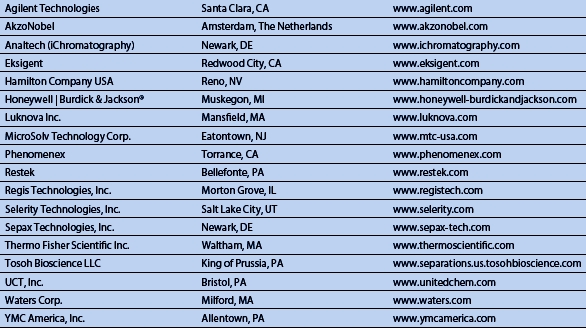Featured Article

Please see our LC Columns / HPLC Column section to find manufacturers that sell these products
Liquid chromatography columns, or LC columns, have been used in the food, chemical, petrochemical, and pharmaceutical industries and forensic, clinical, and medical determinations for sample purification and analysis. In an LC column, the sample interacts with the mobile phase and the stationary phase and is partitioned into its components.
There is a wide range of LC columns to choose from based on the specific applications.
LC methods
An LC column may include an analytical column and a guard column. The guard column is placed before the analytical column to protect it from contamination. The guard column is usually shorter than the analytical column, and contains the same packing material and stationary phase as the analytical column.
In a high-performance liquid chromatography (HPLC) column, the sample is partitioned by liquid–liquid interactions. The stationary phase is a liquid film bonded to the packing material with an organosilane compound. HPLC columns may be endcapped. In endcapped HPLC columns, interactions between the sample components and any unreacted organosilane compound can be avoided by the addition of a neutralizing agent.
Liquid–solid chromatography column
In a liquid–solid chromatography (LSC) column, the sample is partitioned by liquid–solid interactions. The mobile phase is nonpolar and the packing material serves as the polar stationary phase.
Ion exchange chromatography column
In an ion exchange chromatography (IEC) column, the sample is partitioned by ion exchange.
Size exclusion chromatography column
In a size exclusion chromatography (SEC) column, the sample is partitioned by size exclusion with the smaller samples remaining in the stationary phase while the larger components elute first.
Chiral chromatography column
In a chiral chromatography (CC) column, enantiomers of a racemic mixture are partitioned by selective interaction with the stationary phase.
Purchasing considerations for LC columns
In choosing an LC column, many factors require consideration.
Application
An important consideration in selecting an LC column is its area of application.
Agilent Technologies offers the Bio SEC-3 and SEC-5 columns, which are suitable for the separation of peptides, globular proteins, protein conjugates, and large biomolecules. ZORBAX GF-250/450 columns are intended for size separations of proteins and other biomolecules; the ZORBAX Eclipse XDB is well suited for the analysis of smaller molecules and biomolecules.
Agilent Technologies also offers preparative and process columns. The Prep LC purifies milligram to gram quantities of samples. The ZORBAX Prep HT is appropriate for scaleup, and the PLRP-S for cGMP production.
Analtech (aka iChromatography) provides the PHENYL column with preferential retention of aromatic compounds; MEB columns, which are suitable for the analysis of hydrophobic components; and the C8 and C18, which are useful in drug discovery, genomics, and proteomics.
Thermo Fisher Scientific Inc. offers BioLC columns for protein, peptide, carbohydrate, monoclonal antibody, and oligonucleotide characterization.
Microsolve Technology Corp provides Cogent TYPE-C silica hydride based columns, Cogent RP and Cogent IEX.
Mode of separation
In a normal phase LC column, the stationary phase is polar and the mobile phase is nonpolar. Silica, DIOL (OH), Aminopropyl (AP), and Cyanopropyl (CP) columns from Analtech (iChromatography) are normal phase columns.
In a reversed phase LC column, the stationary phase is nonpolar and the mobile phase is polar. Reversed phase columns include the MEB, Octyl (C8), Octadecyl (C18), and PHENYL from Analtech (iChromatography).
In an IEC column, the stationary phase is a resin with ionic functional groups. An example of an IEC column is the Dionex™ IonPac™ column from Thermo Fisher Scientific Inc.
In an SEC column, the stationary phase is silica or cross-linked resin beads. Acclaim™ columns from Thermo Fisher Scientific Inc. are SEC columns.
Packing materials
The packing material has an impact on the performance attributes of the LC column and is an important consideration in selecting an LC column.
The U.S. Pharmacopeia (USP) assigns a USP designation to packing materials (example: www.chem.agilent.com/en-US/Products-Services/Columns-Sample-Preparation/LC-LC-MS-Columns/Pages/usp.aspx).
Packing materials may be porous silica, ceramic microparticles, or monolithic silica rod. The packing materials of the ZORBAX Rx-SIL, ZORBAX SIL, and ZORBAX HILIC Plus from Agilent Technologies are porous silica microparticles.
The silica packing material may be chemically treated. The packing material of the Polaris C18-A column from Agilent Technologies includes octadecyl silane chemically bonded to silica. Analtech (iChromatography) provides the MEB columns with hydrophobic packing material with 1% to 3% carbon on the silica substrate.
MicroSolv Technology Corp. offers the TYPE-C™ silica-based HPLC columns, which have a silica surface with silicon–hydride groups.
Packing materials for IEC columns are strong or weak acid cation exchangers, or strong or weak base anion exchangers. The packing material of the BIO-SCX NP10 IEC column from Agilent Technologies is a cation exchange sulfonated cross-linked styrene–divinylbenzene copolymer.
Packing materials for SEC columns are molecular sieves, polymers, and silica. The packing material of the PLgel SEC column from Agilent Technologies is a rigid, spherical styrene–divinylbenzene copolymer.
The packing materials for CC columns are metal chelates, amino acid derivatives, proteins, helical polymers, and cyclodextrin derivatives. The packing material of the ChiraDex CC column from Agilent Technologies is a beta cyclodextrin bonded to porous silica particles.
Several providers offer packing materials for custom applications.
Analtech (iChromatography) supplies packing materials for reversed phase, normal phase, and ion exchange chromatography.
Customization
Most providers offer customization options.
Representative LC columns
A list of representative LC columns is given in Table 1.
Table 1 – Representative LC columns

Looking ahead
One development to watch for is the transformation from HPLC to ultrahigh-pressure liquid chromatography (UHPLC).
Providers
Table 2 lists providers of LC columns.
Table 2 – LC column providers

Lina Genovesi, Ph.D., JD, is a Technical, Healthcare, and Business Writer based in Princeton, NJ; e-mail: [email protected]; www.linagenovesi.com
Please see our LC Columns / HPLC Column section to find manufacturers that sell these products